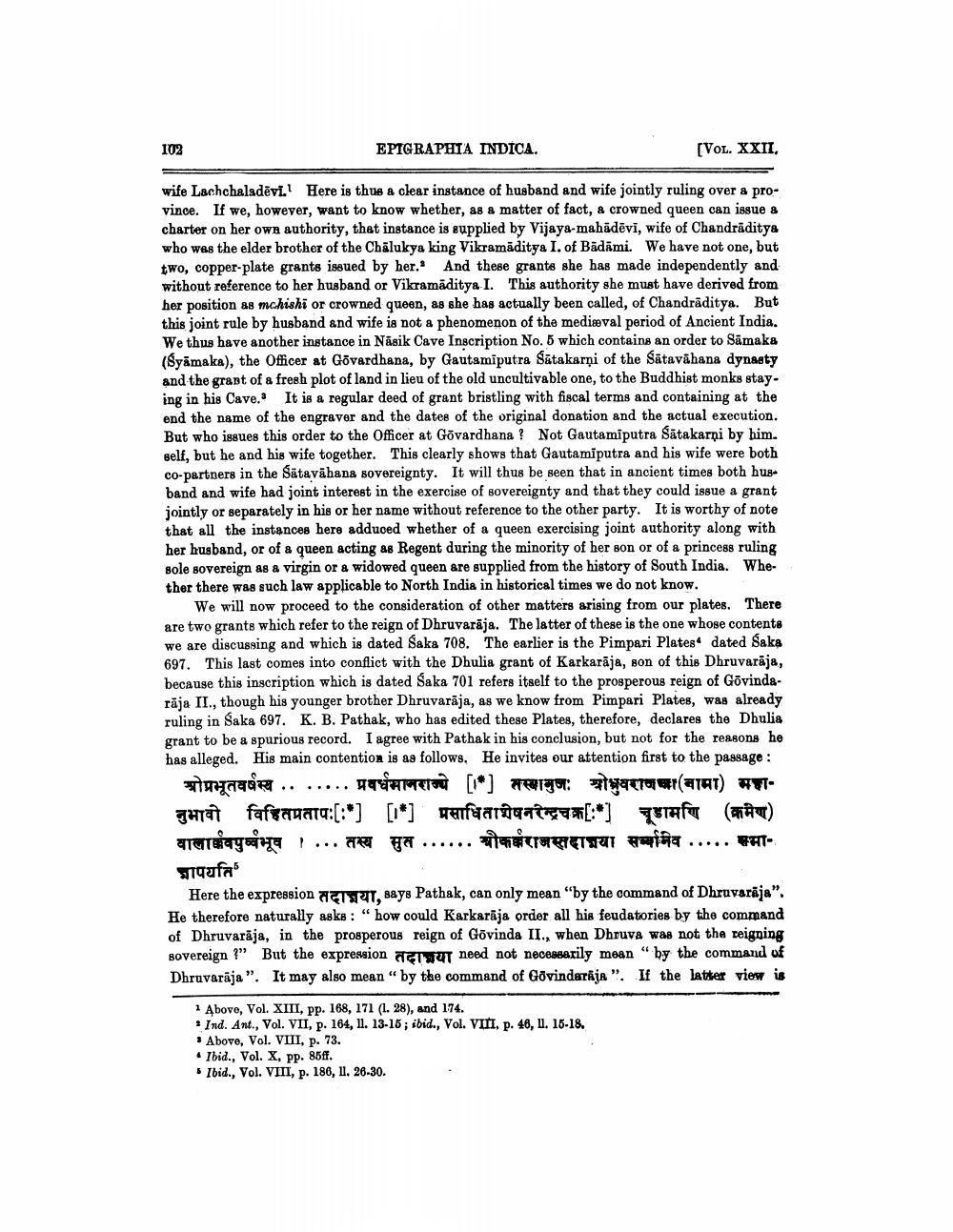________________
102
EPIGRAPHIA INDICA.
(VOL. XXII.
wife Lachchaladēvi. Here is thus a clear instance of husband and wife jointly ruling over a province. If we, however, want to know whether, as a matter of fact, a crowned queen can issue a charter on her own authority, that instance is supplied by Vijaya-mahadēvi, wife of Chandrāditya who was the elder brother of the Chalukya king Vikramaditya I. of Badami. We have not one, but two, copper-plate grants issued by her. And these grants she has made independently and without reference to her husband or Vikramaditya I. This authority she must have derived from her position as mchishi or crowned queen, as she has actually been called, of Chandräditya. But this joint rule by husband and wife is not a phenomenon of the medieval period of Ancient India. We thus have another instance in Nāsik Cave Inscription No. 5 which contains an order to Sämaka (Syāmaka), the Officer at Govardhana, by Gautamiputra Satakarni of the Satavahana dynasty and the grant of a fresh plot of land in lieu of the old uncultivable one, to the Buddhist monks staying in his Cave. It is a regular deed of grant bristling with fiscal terms and containing at the end the name of the engraver and the dates of the original donation and the actual execution. But who issues this order to the Officer at Govardhana? Not Gautamiputra Satakarņi by him. self, but he and his wife together. This clearly shows that Gautamiputra and his wife were both co-partners in the Sātavāhana sovereignty. It will thus be seen that in ancient times both husband and wife had joint interest in the exercise of sovereignty and that they could issue a grant jointly or separately in his or her name without reference to the other party. It is worthy of note that all the instances here adduced whether of a queen exercising joint authority along with her husband, or of a queen acting as Regent during the minority of her son or of a princess ruling sole sovereign as a virgin or a widowed queen are supplied from the history of South India. Whether there was such law applicable to North India in historical times we do not know.
We will now proceed to the consideration of other matters arising from our plates. There are two grants which refer to the reign of Dhruvarāja. The latter of these is the one whose contents we are discussing and which is dated Saka 708. The earlier is the Pimpari Platese dated Saka 697. This last comes into conflict with the Dhulia grant of Karkarāja, son of this Dhruvarāja, because this inscription which is dated Saka 701 refers itself to the prosperous reign of Govindatāja II., though his younger brother Dhruvarāja, as we know from Pimpari Plates, was already ruling in Saka 697. K. B. Pathak, who has edited these Plates, therefore, declares the Dhulia grant to be a spurious record. I agree with Pathak in his conclusion, but not for the reasons he has alleged. His main contention is as follows. He invites our attention first to the passage:
ar ....... JUANEITÀ [l*] Feige: na teerajat) #91ghrat fafcacata:[:*] [*] nefsariaat [:*) EfT (PAT) Alagoana 1 ... ya ...... TARTETTU wafaa ..... FA
ufas Here the expression Acts , says Pathak, can only mean "by the command of Dhruvarāja". He therefore naturally asks : "how could Karkarāja order all his feudatories by the command of Dhruvarāja, in the prosperous reign of Govinda II., when Dhruva was not the reigning sovereign ?" But the expression ETUT need not necessarily mean" by the command of Dhruvarāja”. It may also mean “ by the command of Govindaraja". If the latter view is
1 Above, Vol. XIII, pp. 168, 171 (1.28), and 174. * Ind. Ant., Vol. VII, p. 164, 11. 13-15; ibid., Vol. VIII, p. 46, . 16-18. . Above, Vol. VIII, p. 73. • Ibid., Vol. X, pp. 85ff. • Ibid., Vol. VIII, p. 186, 11. 26-30.




